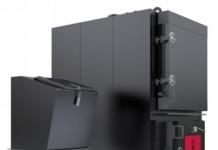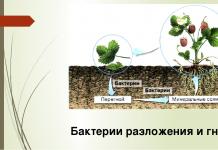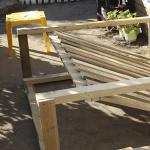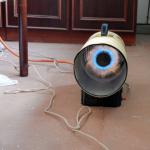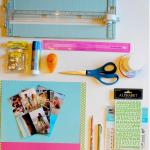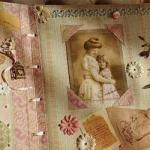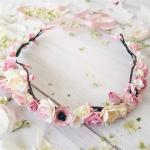Good day, brain talents! You can make a metal rose from sheet copper very quickly and easily, using a minimum of tools at hand, and now I will tell you exactly how.
I've always been interested in working with metal, but never had the time or the right tools to do anything. And when I did find a cheap, easy, and tool-free way to handle metal, I immediately began to “fill” with metal homemade my house. Similar metallic roses crafts, like in this brainarticle, can be a wonderful decoration for your home or an incredible gift for a person worthy of your attention.
From the materials you will only need 2 small metal plates of 22 gauge (approximately 0.76mm), one is copper, the second is steel, and a steel bar with a diameter of 6mm and a length of 30cm, and from the tools:
- hammer
- pliers and needle nose pliers
- metal scissors
- drill and drill bit 6mm
- chisel
- file
- and a friend with a welding machine.
Step 1: Paper Templates
 We print the attached file with templates on an A4 sheet, brainpicture must fill out the entire sheet. Next, we cut out the templates, in those that resemble a propeller, we cut the petals, but do not cut them off from the core (circle in the center).
We print the attached file with templates on an A4 sheet, brainpicture must fill out the entire sheet. Next, we cut out the templates, in those that resemble a propeller, we cut the petals, but do not cut them off from the core (circle in the center).
Step 2: Metal Petals



 Using the cut out petals and sepals (that part of the rose that hangs from the bottom of the bud), mark the contours of the petals on metal plates with a marker, and then cut them out, just as it was with paper counterparts.
Using the cut out petals and sepals (that part of the rose that hangs from the bottom of the bud), mark the contours of the petals on metal plates with a marker, and then cut them out, just as it was with paper counterparts.
It may be easier to do this if you first roughly cut each petal blank separately, and then cut the details along their edges, and if brain-edge are uneven, they can be processed with a file.
Tip: when cutting metal, try not to completely close the scissors, otherwise, if the tips of the scissors close together, then as a result the edge will turn out to be very uneven.
In the center of the metal blanks of the petals and sepals, we drill a hole with a 6mm drill.
Note: I apologize in advance that in the presented photos with the brain process I do not use protective equipment, BUT when cutting petal blanks and drilling holes, wear PROTECTIVE GLOVES!
Step 3: Applying the Texture


 With a chisel and brain hammer we punch the edges of all the petals so that they look like they are scratched in the direction from the center to the edges. There is no need to fully texture the petals, so on the finished homemade only the outer edges of the petals will be visible. We just scratch the outer edge on ¾ of the petal.
With a chisel and brain hammer we punch the edges of all the petals so that they look like they are scratched in the direction from the center to the edges. There is no need to fully texture the petals, so on the finished homemade only the outer edges of the petals will be visible. We just scratch the outer edge on ¾ of the petal.
Tip: if you have a hatchet, a pointed hammer or something similar with a sharpened edge, then you can use them to apply shallow texture scratches. The pointed end of the crowbar is perfect for this purpose.
But for applying the grooves of the sepals, you need to be more accurate. First, with a marker, draw grooves on the leaves of the sepals, just as shown in brain photo, and having done this, we break through all these grooves with a hammer and chisel. Then, by erasing the marker, we get the finished sepal!
When the entire set of petals and sepals is done, we clean them with a metal brush to bring shine.
Step 4: Stringing the Petals and Sepals onto the Stem




 With a hammer, we give one end of the metal bar the shape of a square for a length of about 4 cm from the edge. This square shape of the rod will tightly fix brainpetals on a stem and will not allow them to rotate along that stem.
With a hammer, we give one end of the metal bar the shape of a square for a length of about 4 cm from the edge. This square shape of the rod will tightly fix brainpetals on a stem and will not allow them to rotate along that stem.
Next, we take the sepal, and on top of it we fold the petals in descending order of size, while all the textured surfaces should be on top, and string them on the square end of the stem, about 6mm, the main thing is that they sit tightly on the stem.
Note: For stringing, I used a small head. I just put it with the notched end of the stem and pressed it on the petals so that they were firmly fixed.
After that, it remains only to weld the petals. Just need to put a few dots brain welding to secure the petals and sepals - a couple of points on top and a couple on the bottom. There is no need to weld the petals together.
Step 5: Folding the first 2 layers of petals

 The first layer, consisting of only three petals, you just need to bend up and inside each other. Just take the right edge of the first petal with needle nose pliers and twist it from the outer edge up to the center. We repeat the same procedure with the remaining two brain petals. The result should be a three-lobed spiral with the inner edges touching and the outer edges sticking out, looking something like a pin-wheel wind toy.
The first layer, consisting of only three petals, you just need to bend up and inside each other. Just take the right edge of the first petal with needle nose pliers and twist it from the outer edge up to the center. We repeat the same procedure with the remaining two brain petals. The result should be a three-lobed spiral with the inner edges touching and the outer edges sticking out, looking something like a pin-wheel wind toy.
Then we take the protruding, left edge of the petal and bend it to the left to the neighboring petal, and if you look from above, then the shape of the petal bent in this way should resemble the letter “C”. We do the same for the remaining two petals, and as a result, the petals should “close” around each other. If they are still separated from each other, then with ordinary pliers we press them into a tight spiral in the field.
Do the same with the second layer of petals. We bend one of the edges of each petal up and inward, and the second edge is also inward, forming the letter "C". However, this time it is necessary to bend 3 mm of the upper edges with pliers and twist them slightly. This will emphasize the petals when viewed from above and give brainrose more realistic look. And to complete the manipulations with the second layer of petals, you need to bend the outer edges of the petals a little inward with the help of needle nose pliers, giving the bud a denser look.
Step 6: Folding the Remaining Three Layers of Petals




 We bend the third layer in the same way as the first two. We bend them up and bend them in the shape of the letter "C". And we also slightly twist the upper edge of the petals, but now we twist the left and right sides of these upper edges separately. This will give a twisted top brain edge a slightly triangular shape, which is more natural for a rose than just a twisted petal.
We bend the third layer in the same way as the first two. We bend them up and bend them in the shape of the letter "C". And we also slightly twist the upper edge of the petals, but now we twist the left and right sides of these upper edges separately. This will give a twisted top brain edge a slightly triangular shape, which is more natural for a rose than just a twisted petal.
We form the fourth and fifth layers in a similar way, with each layer more clearly showing the sharpness of the curved edges of the petals. The edge of the third layer should be rounded and with only a hint of sharpness, the edge of the fourth layer should be somewhere between round and triangular, and the edge of the fifth one should be distinctly triangular.
In addition, we take the petals of the fourth and fifth layers with pliers at a distance of 1.2 cm from the upper edge and bend them slightly into an arc so that they do not “grow in a straight line” from the stem. This will give the rose- homemade volume and, when viewed from above, it will not be too flat.
Step 7: Curling the Sepals
 We take the leaves of the sepals with pliers and bend them in the opposite direction from the bud, closer to the stem. At the same time, we also bend the tips of these leaves so as not to prick about them when we hold brainwashing in hand.
We take the leaves of the sepals with pliers and bend them in the opposite direction from the bud, closer to the stem. At the same time, we also bend the tips of these leaves so as not to prick about them when we hold brainwashing in hand.
Step 8: Polishing


 It remains only to take a metal brush or a wire sponge and polish your metal rose to a shine -under the tree. You can also take clear polyurethane and apply it to the surface of your rose to protect it from rust, but that's optional!
It remains only to take a metal brush or a wire sponge and polish your metal rose to a shine -under the tree. You can also take clear polyurethane and apply it to the surface of your rose to protect it from rust, but that's optional!
If you want to continue this creative brain process, then you can cut a few more leaves out of metal and weld them to the stem, as you like it. At the same time, if one leaf is quite large and flat, then you can attach a candle to it, and your rose will thereby turn into a very beautiful candlestick.
So, craft ready, thank you for your attention!
Today we will tell you how to make a rose from metal with your own hands.
Hello readers!
In this article I want to tell you about how you can make beautiful metal roses without any special skills in working with metal! (Video of the process at the end of the article)
For motivation, at the end of the article I will show you my first rose and the one I made just recently. Along the way, I will talk about my observations and those things that I did not immediately understand, but they significantly improved the appearance of the flowers.
And also at the end I will post a block with frequently asked questions that you might have in the process of reading.
And so, let's go!
Materials needed to make a metal rose:
- I make my roses from cold-rolled black metal sheet 0.5 mm thick;
- I use A1 smooth reinforcement and 6 mm knitting wire as stems. diameter for forging stems with spikes and texture. For simpler options, 5 mm knitting wire is quite suitable.
Equipment and tools needed to make roses from metal:
- a welding machine (in fact, if you are smart, you can do without a welding machine, but that will be another story.);
- Bulgarian;
- metal scissors;
- thin nose pliers;
- pliers;
- felt-tip pen / scriber.
You, as masters of homemade products, can completely do without this or that: a grinder can replace scissors, pliers (pliers) can replace thin-nosed pliers. The difference will be only in the complexity of some processes.
And since we have discussed the instrument and I have touched on the topic of improvisation, I will add that in fact this article is not a panacea, not a strict instruction. This is a motivational letter describing technological features! The most important thing in working with a metal rose flower is not to try to repeat me or yourself. Be more relaxed. Let your movements in the work be even slightly careless, the petals are crooked, and the bends of different widths. It is these movements that will breathe life into your flower!

My rosebuds consist of the following number of petal plates:
- outer first sheet - 5 rose petals, circle diameter about 12 cm;
- the second sheet - 4 rose petals, the diameter is slightly smaller, about 11 -11.5 cm;
- third sheet - 4 rose petals, diameter 11-11.5 cm;
- fourth sheet - 3 rose petals, diameter 10.5 cm;
- fifth leaf - 4 rose petals, narrow like a propeller and about 9-10 cm in diameter;
- five-leaf asterisk - it will serve as a leaf on the outside. Diameter 8-9 cm.

Metal rose leaves look like this:
- for one flower, I harvest 2-4 branches of leaves, 2-4 leaves on each. Most often I use 2 branches of 3 leaves. A certain average figure, so that the flower is not empty and does not seem like a whole bush. Again, decide for yourself, try on, try.

Metal forged rose stem:
- on average, I take a stem length of about 50 cm. This makes the flower quite large and beautiful in the end with the size of the bud that I wrote above.
I also made flowers 30 cm and 60 cm each. This is the beauty of working with metal. We have a lot of options for you.

Let's start making roses out of metal.
- First of all, I usually mark out the squares for future rosebud petals. I make 3 squares 12x12 cm and 3 squares 10x10 cm. To make it easier to drill a pack of the same type of figures later.
- After cutting out these squares, I stack them and mark the center. Then I drill all the workpieces at once by 6-7 mm. Ok, they screwed up. Since I make quite a lot of flowers, I have ready-made templates so that I don’t mark the sides of the petals each time, this is especially dreary with the cinquefoil.
- I trace the outline, start cutting. I don’t particularly try to get into the line, in the finishing all the curvature of the rose petals will turn into their beauty.
From personal experience, I can say that it is most convenient to first cut out a circle along the circled outline, then it is worth cutting one side of the rose petals from the outside to the center. After turning the workpiece over and in the same position, cut through the remaining sides. You will immediately understand what I mean when you try to cut the workpiece along the contour without turning the sheet over. At first it will be inconvenient, because there is no marked outline on the reverse side. But your hand will get used to it. Mine is used to it. - Well, the rose petals are cut out. Now we take on the leaves. I always draw them by hand, since symmetry is not needed there and I also cut them out with scissors along the contour.
I also note here that do not be afraid to bend the metal in your hands when you go along the cut contour with scissors, later we will straighten everything before further work.

I like to prepare everything first, and then start assembling and welding as a final operation. Therefore, I also cut off the stem of the desired length, heat it in various ways: by welding, simply. I've tried it all. Everything is working. And I give texture to the stem of the rose. I crush him mercilessly! After such processing, the stem of the rose is obtained in an arbitrary shape with an interesting pattern. If you continue to bother, then you can weld spikes by simply fusing small cones and processing them with a grinder.
I use petal circles for this case. I clamp the grinder in a vise, and rotate the stem with my hands. In this way, it turns out to sharpen the spikes to an acute state.
To give texture to the metal rosebud, I use a makeshift anvil, on which I hammered a notch with the sharp part of a hammer. So I just put the petal on the anvil and tap on the back with a rounded mallet. The texture is perfectly transferred from the anvil to the petals.

I make a notch on the leaves with a chisel and use thin-nosed pliers to twist their rose stems into a tube. Many blacksmiths make welded leaves in their practice. The version that we make with you is more refined and pretty, more lively.

Time to assemble the finished metal rose!
I clamp the stem of the rose in a vise so that the tip barely rises. And, following the sequence, I collect the bud, welding each layer through the drilled hole to the stem and the previous layer of petals:
- first I lay an asterisk-leaf;
- then the cinquefoil;
- large quatrefoil;
- large quatrefoil;
- trefoil;
- leaf propeller.

Do you feel like you have almost made a flower? Yes it is! It remains to play with the shape of the bud and everything will be finished.
One by one, we fold the first leaf from above into and bend the edges with thin-nosed pliers. Then we bend the trefoil and also bend the edges with thin-nosed pliers. And so on... Don't get hung up on one form. Try it, even if you like the rose flower as it is in front of you now. Believe me, there are a lot of interesting forms. They suit different colors and occasions in different ways.

Metallic rosebud on a stem. It remains only to add the leaves. Add to taste, it is impossible to overdo it or not to get it. Are you an artist. You know better =)

Often I am asked to paint flowers in classic colors: red bud and green stem. Do not forget that in an attempt to catch up with nature, we will only be able to show the shortcomings of the flower in front of the uniqueness of the living. It's up to you, but now I finally gave up painting. I try to emphasize the graceful look of the metal by exposing it. Sometimes I cover the protruding parts with brass. It turns out a very beautiful expensive vintage flower. And if it is practically impossible to give some form to a living flower, then look what you can do with our metal roses, which we made with our own hands!
(only a small part of my work execution options)

Answers to the questions asked:
- Why don't I take 2 or 3 mm. ?
Many blacksmiths always take on thick metal, belittling the dignity of thin. Any variant of execution has a place to be. But thin metal is both lighter and easier to work with, and therefore, at least, it is easier to learn from it. - Why knitting wire (heat-treated) ?
It can be textured without warming up, as it is much softer than plain steel reinforcement. - Why is it important to make the outer leaf of a rose with 5 petals?
The more outer petals on the leaf, the rounder the rosebud will be. With four petals, the bud is square. More than 5 - it will no longer look like a rose. - How to cover a brass rose made of metal with your own hands?
There is a little trick for which we need a brass drill brush.
We heat the metal a little and start working on it with a brush. Brass is very well transferred to the metal and covers it with a high-quality brass layer. The more you heat the metal before brushing, the more yellow the brass will be. Don't overdo it, or you'll burn it out.
All photos and video materials from this article were taken by me, as well as the flowers on them.
A handmade gift is always remembered more strongly and arouses admiration. You put your time, effort and soul into it. Flowers are beautiful, but short-lived. Iron, handmade, is a wonderful gift that will delight for many years and make an indelible impression on the recipient.
Materials and tools for creating an iron rose
- welding machine (semi-automatic or inverter; for inverter, use electrodes 2 mm thick at a current value of 50-70 A)
- angle grinder or grinder (with cutting and grinding discs; it is better to use a cutting disc 1 mm thick, and a grinding disc - petal type)
- drill with drills for metal with a diameter of 0.5 - 1 cm
- iron rod with a diameter of 8-12 mm (for flower stems)
- sheet iron 0.5 mm thick; (you can use metal from the hoods or fenders of the car, its thickness according to GOST is 0.5 - 0.8 mm)
- gas burner, or any other heat source
- 300 g of engine oil (preferably unused)
- round nose pliers
- felt-tip pen
Cut out 4 squares from an iron sheet with a side of 10 cm. If you want your rose to be more magnificent, prepare 5 squares.

Draw on the squares the shape of future petals, and on one of them - a kind of "wind rose". This will be a blank for the sepals, so do not try to achieve perfect symmetry - nature makes each of its creations individual.




Take an iron rod, if necessary, shorten it to the desired length - this is the stem of the future rose (40-50 cm).

Now you need to make holes for the stem in the cut blanks of the petals. There are 2 ways - drilling and welding.
Using a drill, we drill a hole strictly in the center, the diameter of the hole should correspond to the diameter of the rod. If the diameters don't match, let's say you chose a 12mm rod and the thickest drill you have is 8mm, then drill 3 holes side by side so that you get one hole of the right size. Bend the inner edges with round-nose pliers or thin pliers. The rod must fit tightly into the holes, otherwise it is difficult to weld it.

Use a 3 mm thick electrode and set the current to about 100 A. Bring the electrode to the center of the petal and start the arc. Press the electrode into the metal, piercing it through. Since we use thin sheet iron, it will burn through easily. But be careful, the hole should not be too big.

Tip: You don't have to make perfectly round holes. They must be made such that the rod is in contact with them by at least 50% of its diameter. This is a prerequisite for proper welding and strength of the entire structure. In the process of making holes, periodically apply a rod to them, this will allow you to control the process.
Step back 2 cm from the end of the rod. Now put the blanks with petals on it, starting with the sepals. Arrange each layer of petals so that the petals are criss-crossed. Secure each layer by welding. Be careful - thin metal burns out quickly, so melt more rod than petals.

Bend the leaves of the bottom layer down.

Now the most interesting part of the work is the formation of the petals. Heat the still flat petals with a gas burner. Red hot is not necessary, just a little heat is enough. Under the influence of temperature, the metal becomes ductile, better molded and the likelihood of unwanted deformations is reduced.
With thin pliers or round nose pliers, bend the 2 central petals so that they are wrapped inside each other. Bend the rest of the petals around them.

Layer by layer, bend all the petals, bending the tips in the opposite direction.

Now we need to make rose leaves. Draw their outlines on the metal sheet. They may not be the same either.

Cut the leaves with a grinder.

On both sides of the leaves, make notches, as shown in the photo.
Carefully! Hold the leaves only with pliers, in no case with your hands !!!
Change your grip as you cut. Hold the sheet by one edge and make notches on the other, then vice versa.

Bend the leaves with your hands and attach them to the stem of the rose at the weld points. Be careful not to burn them.


Rose is ready. But raw metal will rust over time, and corrosive processes must be prevented. There are many options - spraying, varnishing, you can even paint a rose in the colors of a living flower.
I preferred to do the bluing. To do this, you need to heat the rose, cover it with engine oil and heat it again so that the excess oil burns. Work should be carried out only in a ventilated area, and preferably in the open air, since when heated, the oil will smoke.
Do-it-yourself tin roses
Good afternoon, in this letter I will try to tell the whole process of making roses from tin, which can be a great gift for loved ones.
To create a rose from tin, you need a minimum of tools:
Pliers
Metal shears
Ruler
Pencil
If possible, a compass
Tin roses step by step:
So, we need metal mugs - you can use roofing iron or simple tin cans. We cut out circles of different diameters, from about 150 to 130 mm - a difference of 5 mm each, i.e. 150-145-140-135-130... They will need 5 pieces - this is a blank for the flower itself.
2.
3.
Then cut out two strips about 2.5 cm wide. One should be 110 mm long and the other 125 mm - this is on the inner leaves of the flower.
Then we need a star - fashionably four-pointed. We cut it out of a circle with a diameter of 110 mm - this will be the lower part of the flower.
4.
On a separate sheet of metal, we draw and then cut out the leaves themselves - just 1 single and one triple ... I think it's better ... then we cut notches along the edges of the leaves - a real view of a real leaf appears ... and you can knock out the veins in the middle of the sheet with a simple screwdriver .
5.
Then we bend the leaf stem inward - with pliers ... and we get a finished sheet ... Here - we need another piece of wire - it can be 6 in diameter - I make these ... and a piece can be a copper tube to cut an internal thread on one side under the M6 screw - this is to screw the entire assembled rose with a screw ... a bud ... and on the other hand, we simply solder it into the wire.
6.
And so we cut out four-leaf flowers from circles of metal and press each leaf as shown in the photo with pliers ... squeeze it into a vase and turn the edges a little - also with pliers ... then, when everything is ready, insert all the baskets one into one and edit the bends of the leaves by eye ... then we drill a hole for the screw in the middle and twist it to the prepared tube - we solder the tube to the wire and fasten the leaves with a ribbon of metal prepared earlier ... - the edges can be soldered ... that's all ...
7.
From such tin roses, you can make anything that comes to mind - a hanger, a lamp, use it to decorate a gate, etc.
Round rolled O10, square # 10. Cut out petal blanks from the sheet. 
We heat the rod O 10 and, stepping back from the edge of about 40 mm, we forge the transition to O8. 
Then we clamp the workpiece in a vice and upset the remaining end to O 12-13. We trim the boss and make a cut on the backing chisel at a distance of 5-10 mm from the edge - this will be the rod for the rivet. 
Pull back the rod by # 6-7mm.
In crimping, we roll the rod to O 6mm. 
Now let's get to the spikes. To forge a spike, the stem is forged up to 8, leaving part of the rod (l = 10mm). 
Then, on the edge of the anvil, with two or three sharp blows of the hammer, we delay the performance. You have to hit very accurately. 
Then we clamp the workpiece in a vice and plant the protrusion through the adapter (bar). 
The spike is ready. We forge others (how many we planned) and complete the stem. 
It's time for the petals. On the petals, it is necessary to lower (make thinner) the edges and outline the veins. Well, you can do without veins, but I'll do it. 
Let's form the petals. 
As well as the lower petals. 
And the middle of the corolla. 
It's time to "grow" the leaves. To do this, heat # 10, pull the end onto a cone and, leaving about 45 mm, make a neck for the handle. 
We break the workpiece, giving it the shape of a sheet. 
We put veins on the leaf.
And we pull the cutting.
You can collect "to the heap".
Assembly order forged roses
Let's start assembling the flower. We clamp the stem in a vice, put the whisks on the rivet rod and seal them. We rivet st

